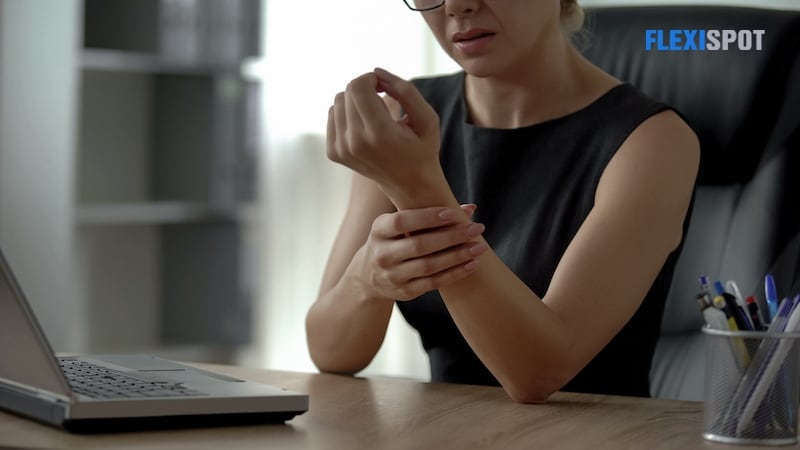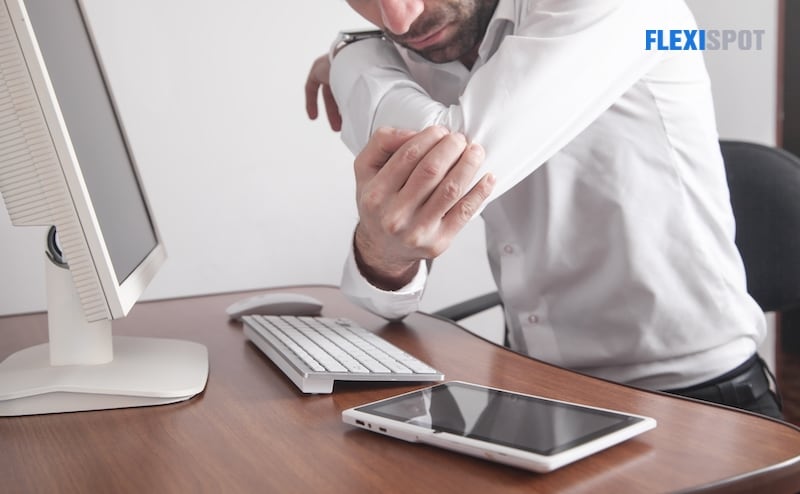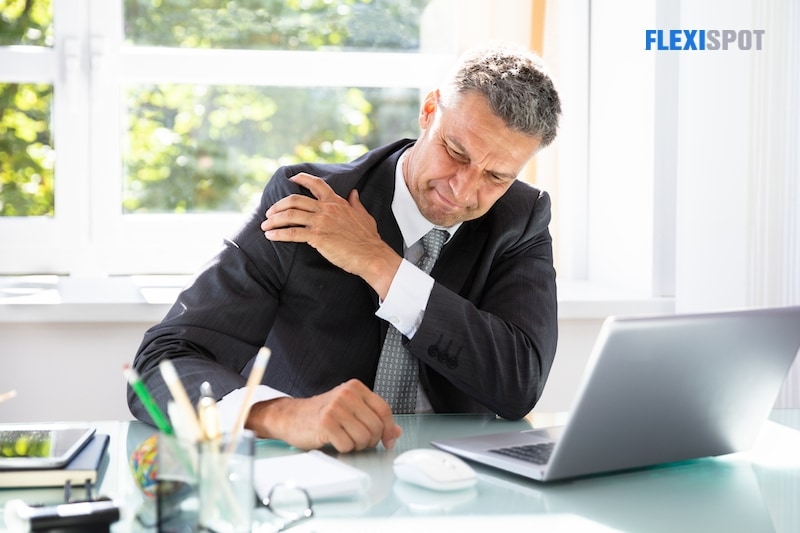In recent times, the traditional work lifestyle has taken a new shape. These days we sit at the desk for hours filing documents, working on computers, drafting, or doing whatever our jobs require.
Not only has this conventional work system shaped how we perceive work, but it has also affected the way our body functions.
You’d wonder why some diseases are suddenly rampant with people that practice this new working system. It’s because our bodies aren’t programmed to sit for 8 to 10 hours. If anything, we’re more inclined to active work system. Like hunting, walking, construction work, moving around, or parenting.
Our newly acquired sedentary lifestyle is responsible for diverse health issues like cardiovascular disease, diabetics, and a host of problems resulting from improper ergonomics. The extended sitting hours can also cause injuries to your muscles and bones.
Below, we have listed eight common workplace injuries that stem from sitting for long hours. You will also find active ways to avoid or minimize these injuries. Keep scrolling.
Carpal Tunnel Syndrome (CTS)
Carpal tunnel syndrome is a disorder or repetitive stress injury that causes pain or weakness in the hand and wrist. It causes numbness and dull aching in your wrist and hand. The cause of CTS is bending your wrist at a wrong angle repetitively while typing or using a mouse.
This condition is one of the most common workplace injuries in the modern work setting. It occurs in about 4 to 10 million people in the United States. Although it can either be mild or severe, the recovery usually takes weeks or months. And if not well manages, it aggravates and becomes extreme and, in some cases, may require surgery.
This injury can also cost companies thousands of dollars in compensation claims yearly. So, you can avoid paying exorbitant compensation fees or losing a diligent staff by providing an ergonomic work setting.
Preventive Measures:
Start by getting a working desk and ergonomic chair with the right height recommended for your height. You must ensure your keyboard is the same height as your elbows for the perfect ergonomic posture.
Ensure you rest your hands slightly by your sides at a 90-degree angle to the keyboard while you type. Another way to prevent CTS is by engaging in some wrists and hand exercises. You can consider buying workstation accessories to help you maintain an ergonomic stance while typing.
For instance, you can get accessories like:
Wrist rest: While using a wrist rest, put it under your palm to avoid straining your wrist tendons. If you rest your wrists on it, you risk having an aggravated wrist injury that may result in CTS.
Ergonomic Keyboard: Buy a keyboard that allows your wrist to rest while typing.
Negative tilt keyboard tray: This keyboard tray positions your keyboard such that the spacebar is higher than the function keys. With this position, your wrist will take on a natural angle while you type.
Wrist brace and an alternative mouse
Low Back Pain
People that live a sedentary lifestyle experience low back pain. Studies show that about 31 million Americans experience back pain at one point in their life. So, it’s a common workplace injury riddling most office workers with a low affiliation to ergonomic space.
Low back pain may seem like a minor injury, but it could be debilitating within a short period. And if you fail to tend to it, it can worsen and lead to exacerbated conditions and eventually more injuries in other areas.
Sometimes, workers may sue companies for compensation based on pesky back pains resulting from work. Don’t treat Low back pain lightly no matter how minor it may seem; address all back discomforts quickly.
Preventive Measures:
When you have a terrible work posture, it affects your lumbar spine terribly. That is why you need to habitually sit upright to alleviate any potential discomfort to your lumbar spine.
Another way to go about this is by sitting on an ergonomic chair with lumbar support to keep your back in an ergonomic position all day long. You can also get proper lumbar support when you use an ergonomic lumbar pillow.
Whatever you do, make sure it maintains the natural curve of your spine.
Furthermore, you may consider getting a sit-stand desk for a fluid switch from a sitting position to a standing position. A standing desk keeps you active during work, and nothing helps your lumbar spine better than occasional active breaks between sitting for long hours.
Tennis Elbow
Tennis elbow is also known as Epicondylitis and is common amongst tennis players hence the name. This condition occurs when you injure the tendons of your elbow. But you feel the pain on the outside of your elbow instead of the internal part.
Besides being associated with tennis players, it also occurs with any task that hyperextends or strains the elbow joints. Epicondylitis is often minor; however, it’s rampant in workplaces and can tamper with worker's productivity. And in rare occasions, it may lead to claims for compensation.
The cause of tennis elbow in the workplace is the use of a mouse. Therefore, the syndrome is often called mouse elbow. When you extend your hand and elbow to make minor movements repeatedly, it strains and tears your elbow muscles and tendons. Eventually, it leads to an excessive elbow ache.
Preventive Measures:
Two main options can help alleviate and prevent mouse elbow syndrome. Firstly, try adjusting your posture so you can use your mouse without going through any unnatural movement. Make sure all wrists and elbow movements are as natural as possible.
Also, avoid using your wrists and elbow for repetitive tasks. When you can’t avoid it, do keep it as minimal as possible.
Secondly, you can get an alternative mouse. However, this is hinged on your workflow. You can consider trackballs, trackpads, and sideways mice.
Neck Injuries
It’s funny how people don’t realize their posture causes neck pains. And when a workspace is ergonomically perfect, it becomes difficult to detect if there’s something wrong with the position of the neck. Neck injury occurs when you strain your neck during work, and it’s common in the modern workplace.
Neck injury is a two-way thing. You can avoid it with ease, and it’s also one of the most expensive workplace conditions to manage. It has a slow healing process and may require surgical intervention when it’s acute.
Neck pains are no different. They equally have a long healing process and can take up to a month or more to heal. And if you are not deliberate about the healing process, it aggravates and starts all over again.
Frankly, a neck injury requires detailed attention. Perhaps, it’s one injury you need to avoid.
Preventive Measures:
Again, in this case, your position is crucial to your plans to avoid neck injury while working. So, adjust the heights of your workstations until you can see your screen clearly without bending your neck.
This adjustment includes your screen; the top of your screen should be right in front of your eye.
You can adjust the monitor arm mount of your desktop to balance the height of your screen. And if you use a laptop, you could use a laptop stand with a keyboard and mouse or a dock with a mounted screen.
An ergonomic chair with a headrest also alleviates neck pain; so, you should consider buying one. It also helps to make it a habit to stretch your neck and shoulder frequently and at intervals.
Knee Injuries
Believe it or not, even employees that live a sedentary lifestyle have knee injuries. It’s hard to believe that sitting all day can affect the knees, but that’s the truth.
Your knees are sensitive and fragile. It makes your knees get easily strained when you have a bad sitting posture.
Sitting improperly for long hours causes lateral stress on your knee muscles. This act puts your knee tendons and joints generally in a bad angle. After a long time, it weakens your knees considerably and causes fatigue to your joints. Finally, it may cause knee pains that get disturbing enough to distract you from work.
Perhaps you have a proper sitting posture that doesn’t risk you having knee injuries; you may develop the condition during physical activities.
Preventive measures:
Maintain an ergonomic stance while sitting during work. Your knees should be at a 90-degree angle at all times.
Your feet need to be flat on the floor, and your thigh must be parallel to the ground. Consequently, you should invest in an ergonomic chair with an adjustable pan. This kind of chair will make it easy to maintain an ergonomic posture that puts your knees at rest and in a proper position.
Make sure the angle of your seat is neutral, so you’re not too high or low in your seat. At the same time, tilt your seat slightly downward to reduce the pressure on your thighs.
It may also help to have a standing desk handy. You can adjust your posture periodically, from standing to sitting. Finally, owning an ergonomic anti-fatigue mat would be the icing on the cake.
Herniated Disc
A herniated disc is another kind of back pain that stems from a spinal injury. A rubbery disc separates the human vertebral. This disc acts as a lubricant and a cushion each time your vertebral moves; when you strain or stress, the soft spots of your spinal cord pop out between the discs.
The change can lead to nerve irritation, muscle contraction, nerve damage, and of course, intense pain. Herniated discs can occur at any part of the spinal cord, and they may come with or without pain.
Preventive Measures:
The importance of sitting upright can’t be over-emphasized. Ensure your sitting posture is always perfectly healthy. If you need to lift a heavy load or objects at work, make sure you carry them properly. The best way to lift anything is with your knees and not your back.
Always sit or stand properly with your back straight and your shoulders positioned straight. A shoulder harness may also keep your shoulders in a healthy posture.
Avoid wearing heels while sitting for hours; a flat shoe keeps your foot flat on the floor and eases off pressure from your spinal cord.
Furthermore, engage in active activities between your long sitting hours. Sit and stand at intervals with a quality standing desk or take a walk in between work. And sometimes, if you can, work from a reclined position. Whatever you do, keep your back or spines comfortable always.
Rotator Cuffs Injuries
Your rotary cuffs are in your shoulders, and you can injure them while engaging in manual labor or during office work. Rotary cuff injuries tend to be extreme and expensive. Most times, correcting it requires surgery and follow-up therapy session to regain control of your arm.
You may trigger this condition when you work at unnatural positions that cause discomfort to your shoulders. Or when you raise your arm for a long time.
Preventive Measures:
Don’t put pressure on your shoulders while working; this is one of the easiest ways to injure your shoulder. Additionally, avoid reaching out for things that are above your shoulder level frequently. Especially when they are heavy, invest in a step ladder if you must.
Keep your arms and back in the proper position while working. Avoid putting your arms in an unnatural posture. Finally, having a chair with armrests is also a good idea as it keeps your arms relaxed.
Eye Strain
Although eye strain isn’t a musculoskeletal injury, it can throw a wrench in a worker’s productivity. Not to mention that it can cause a headache that may lead to other injuries.
Eyes strain affects your eyesight gradually until it leads to more issues like dry eye.
Preventive Measures:
You can ease your eye strain in a couple of ways.
Adjust the brightness or ambient lightning of your workspace
Reduce the brightness of your computer and tweak the color balance
Don’t view flickering images
Invest in a monitor with an anti-glare shield or get polarized glasses to reduce eye strain
Position your monitor such that the screen isn’t too close to your face
Conclusion
Workplace injuries are harmful and can have lasting effects if you get careless with them. But with simple exercises or stretches, you can avoid a wholesome of them.
Sometimes, you need a new office workstation to wade workplace injuries off. Stand up at intervals after sitting for hours, take a walk when needed. However, in the long run, it boils down to your sitting posture. A perfect sitting posture is the best way to escape most workplace injuries.








